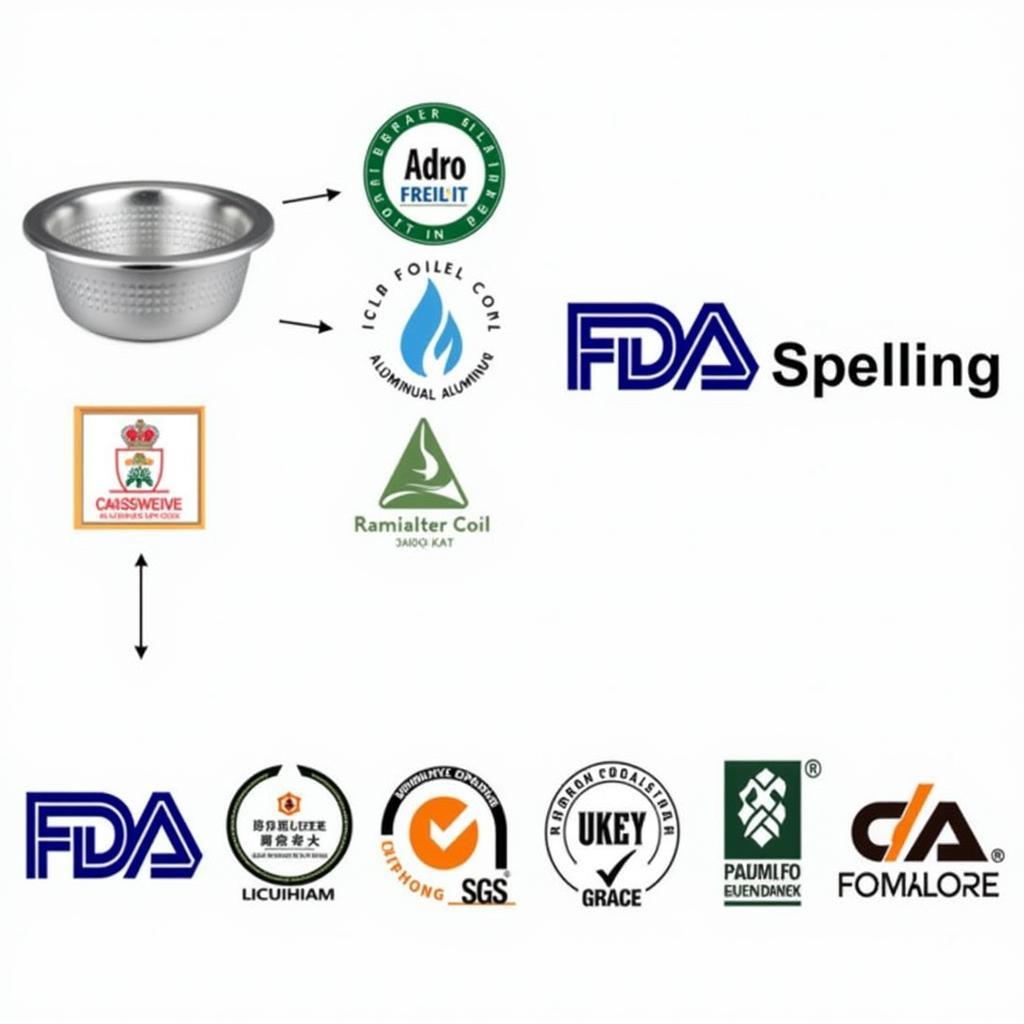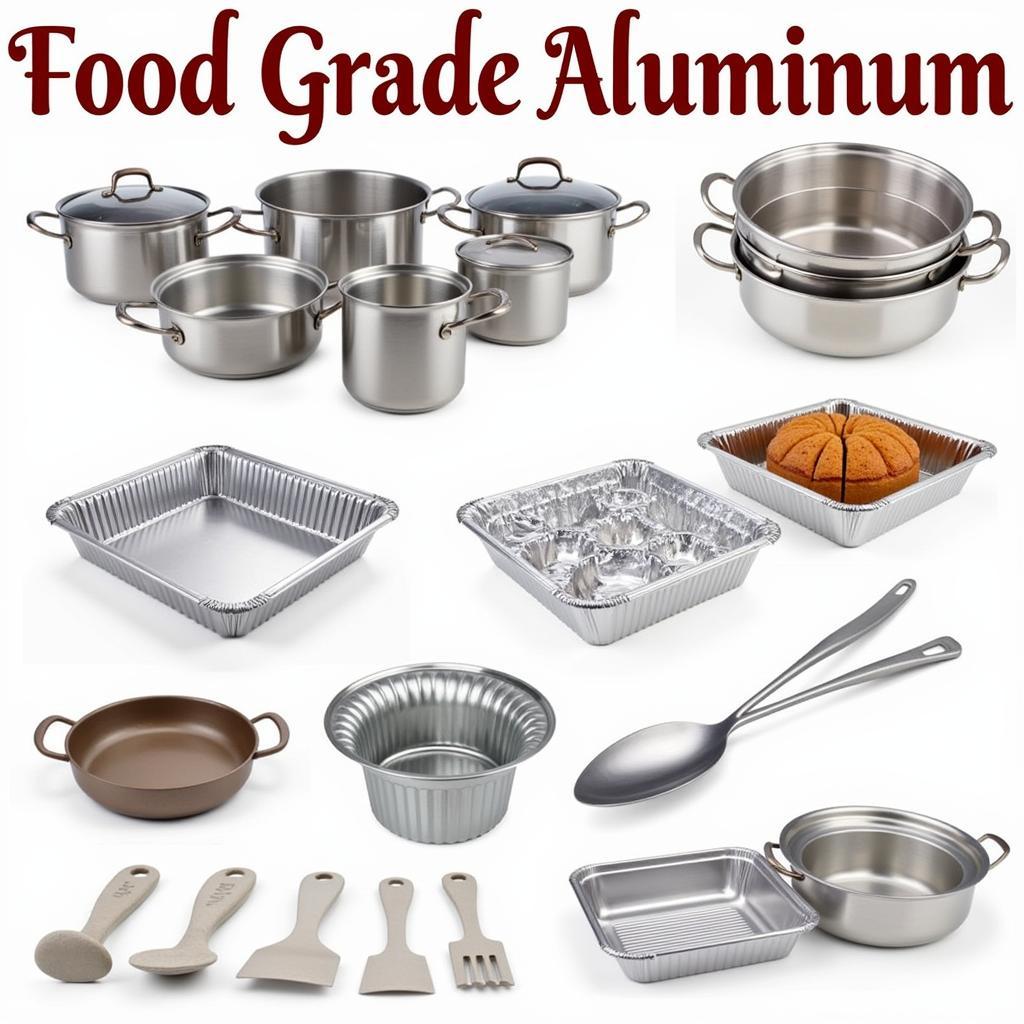Food Grade Aluminum is a common material used in a variety of food-related applications, from cookware and bakeware to packaging and storage containers. Its popularity stems from its lightweight nature, durability, and excellent heat conductivity. But what exactly does “food grade” mean, and is it truly safe for contact with our food? This article will delve into the world of food grade aluminum, exploring its properties, safety considerations, and various uses in the food industry.
Aluminum’s natural resistance to corrosion makes it an ideal material for food contact. Further enhancing its protective qualities, food grade aluminum is often anodized, creating a hard, non-reactive surface. This process not only prevents the aluminum from leaching into food but also increases its durability. You can find more information on safe food packaging options at food safe packaging materials.
What is Food Grade Aluminum?
Food grade aluminum meets specific standards set by regulatory bodies to ensure its safety for food contact. These standards dictate the allowable limits of metal migration into food, ensuring that the levels remain well below those considered harmful. The designation “food grade” essentially assures consumers that the aluminum used in these products is safe for its intended purpose. For those interested in aluminum food storage solutions, check out our aluminium food container.
How Can I Identify Food Grade Aluminum?
While not always explicitly marked, food grade aluminum often carries certifications or markings indicating compliance with relevant safety standards. Look for symbols or designations from organizations like the FDA in the United States or similar regulatory bodies in other countries. These markings provide reassurance that the product meets the necessary safety criteria.
 Food Grade Aluminum Identification Marks
Food Grade Aluminum Identification Marks
Is Food Grade Aluminum Safe?
The safety of food grade aluminum has been extensively studied and confirmed by numerous scientific studies. Regulatory bodies around the world have established strict guidelines to ensure that the levels of aluminum migration from food contact materials remain within safe limits. While concerns about aluminum and health issues like Alzheimer’s disease have been raised, these claims remain largely unsubstantiated by scientific evidence. In general, using food grade aluminum for food preparation and storage is considered safe. Are you unsure about storing hot food? Learn more at can you put hot food in ziploc bags.
What are the Benefits of Using Food Grade Aluminum?
Food grade aluminum offers several advantages in food applications. Its excellent heat conductivity allows for even cooking and baking, making it a popular choice for cookware and bakeware. It’s also lightweight and durable, making it ideal for packaging and storage. Furthermore, aluminum is recyclable, contributing to environmental sustainability. For bulk purchasing options, visit our page on take away food containers wholesale.
Common Uses of Food Grade Aluminum
Food grade aluminum finds its way into numerous kitchen and food industry applications:
- Cookware and Bakeware: Pots, pans, baking sheets, and cake molds often utilize food grade aluminum for its even heat distribution.
- Food Packaging: Aluminum foil, cans, and containers are common examples of food grade aluminum used for preserving and protecting food.
- Storage Containers: Food grade aluminum containers offer a safe and durable option for storing leftovers and other food items.
- Kitchen Utensils: Some kitchen utensils, like spatulas and serving spoons, can be made from food grade aluminum.
 Various Applications of Food Grade Aluminum
Various Applications of Food Grade Aluminum
Caring for Your Food Grade Aluminum
Proper care and maintenance can extend the lifespan of your food grade aluminum products and ensure their continued safety. Avoid using abrasive cleaners or scouring pads, as these can damage the protective oxide layer. Hand washing is often recommended, especially for cookware and bakeware. Learn more about alternative food-safe options like paper sheets for food.
How to Clean Food Grade Aluminum?
Cleaning food grade aluminum is generally straightforward. Warm soapy water and a soft sponge are usually sufficient. For stubborn stains, a paste of baking soda and water can be effective. Avoid using harsh chemicals or abrasive cleaners, which can damage the surface.
Conclusion
Food grade aluminum plays a crucial role in the food industry, offering a safe, durable, and versatile material for various applications. By understanding its properties, safety considerations, and proper care, consumers can confidently utilize food grade aluminum products in their kitchens and everyday lives.
FAQ
- Is food grade aluminum dishwasher safe? While some food grade aluminum products are dishwasher safe, it’s always best to check the manufacturer’s recommendations.
- Can I use food grade aluminum in the microwave? Generally, it’s not recommended to use aluminum foil or containers in the microwave.
- Does food grade aluminum react with acidic foods? While aluminum can react with highly acidic foods, the anodized layer on food grade aluminum minimizes this interaction.
- How can I tell if my aluminum is food grade? Look for certifications or markings indicating compliance with safety standards.
- Is food grade aluminum recyclable? Yes, aluminum is highly recyclable.
- What are the alternatives to food grade aluminum for food packaging? Alternatives include glass, stainless steel, and certain types of plastic.
- Is food grade aluminum expensive? Food grade aluminum is generally affordable and readily available.
Common Scenarios and Questions
- Scenario: Storing leftover tomato sauce in an aluminum container.
- Question: Will the acidity of the tomato sauce react with the aluminum?
- Answer: While some interaction can occur, the anodized layer on food grade aluminum minimizes this reaction and keeps the food safe.
Further Reading
For more information on food safety and packaging, explore our other articles on food safe packaging materials and aluminium food container.
For any further assistance, please contact us at Phone: 02437655121, Email: minacones@gmail.com Or visit us at: 3PGH+8R9, ĐT70A, thôn Trung, Bắc Từ Liêm, Hà Nội, Việt Nam. We have a 24/7 customer service team.